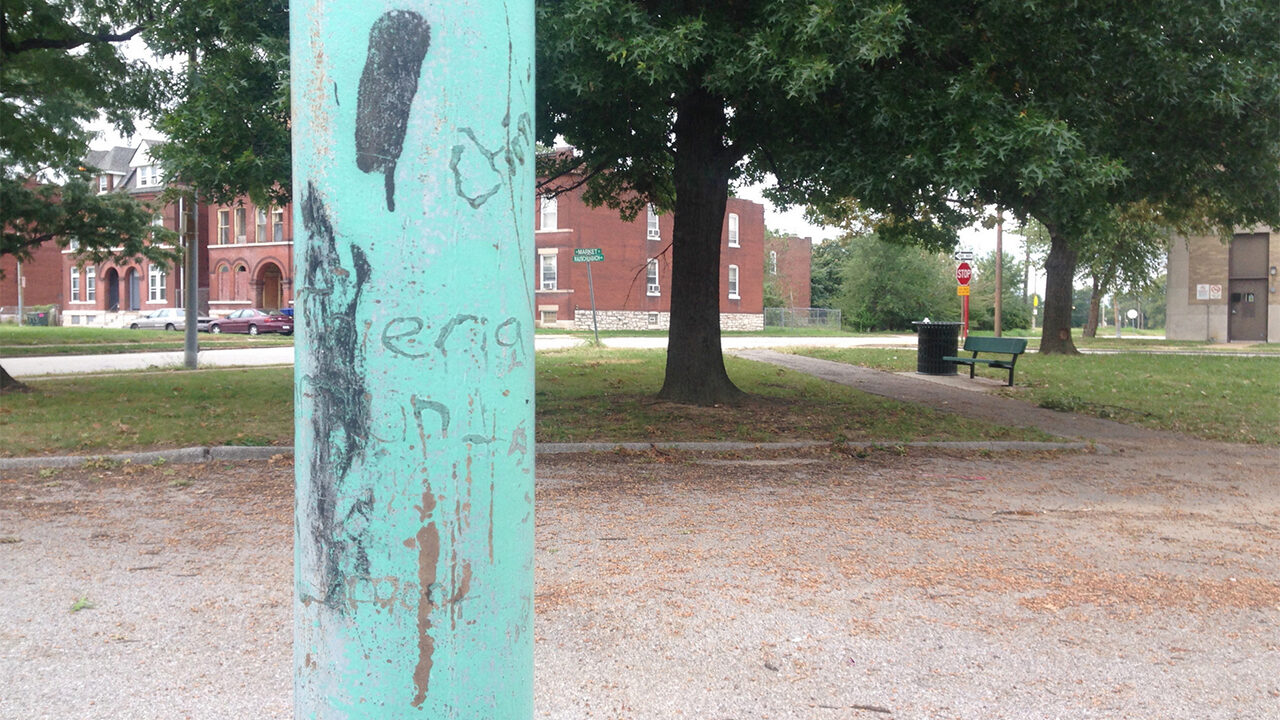
A hard drive was an odd thing to find at a basketball court. But there it lay encased in a patch of frozen dirt at the outdoor blacktop in St. Louis Place Park. Only a few weeks prior I had received an email from the Department of Parks, Recreation, and Forestry indicating they had no information on the history of the court. Neither did the Board of Public Service. Standing along the perimeter of the asphalt, I began daydreaming what stories about the court the digital storage device might hold.
The dearth of information about the basketball court is tragically fitting for a neighborhood that has endured abandonment and erasure for decades. A thriving community of German and Irish immigrants at the turn of the twentieth century, St. Louis Place is today a predominantly African-American neighborhood that has lost more than 60 percent of its buildings since the 1950s. Neglect and strategic blockbusting have gradually turned the area into a prime target for redevelopment.
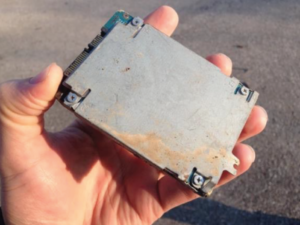
A hard drive found at the basketball court in St. Louis Place Park. (Author photograph)
While many communities throughout St. Louis have suffered similarly, St. Louis Place sits at the heart of some of the most aggressive management in the city. Those efforts culminated in 2016 when the City of St. Louis blighted ninety-nine acres of the neighborhood and offered it as a site for the relocation of the National Geospatial-Intelligence Agency (NGA) West headquarters. The city’s bid won, and public officials were ecstatic. Francis Slay, St. Louis’s mayor at the time, touted the influx of $1.75 million in federal money would “reverse decades of disinvestment in a neighborhood.” Former U.S. Congressman Lacy Clay proclaimed the project a “transformative federal success” before ground was even broken.
Such declarations may prove true, but for whom? Lost amidst the handshaking and backslapping were the neighborhood’s residents. “Some people are paying a heavy price for this plan,” lamented Bob Hansman, retired associate professor of architecture at Washington University, in a 2016 letter to the St. Louis Post-Dispatch, “and not getting anywhere near the support that the plan itself received.”
The basketball court in St. Louis Place Park is located just one block east of the NGA site. Like the neighborhood that surrounds it, the black-top has been allowed to fall into disrepair over the past several decades. Similar courts have long served as important social and recreational spaces for Black communities in urban areas across the United States, but this particular court in North St. Louis continues to bear witness to the dispersal and erosion of Black community.
The weathered court would be easy to dismiss as just another vacant space among countless others in St. Louis. But the court itself reveals a rich material landscape that challenges conventional assumptions about marginalized urban communities. Viewed within the larger ecosystem of race and place in St. Louis, the blacktop invites us to consider counter-narratives of place that problematize widely held views about “run-down” urban spaces and reframe what (and who) is viewed as expendable.

At left, a 1968 aerial view of St. Louis Place showing a densely populated area. The southern portion of St. Louis Place Park can be seen on the right, with the site of the future basketball court marked in yellow. (United States Geological Survey.1968. North St Louis. Big Map Blog. Image cropped by author.) At right, An aerial view of the same portion of St. Louis Place showing extensive clearance of buildings. The basketball court can be seen in the yellow rectangle. (Map data ©2017 Google. Screenshot by author.)
Round and round
St. Louis Place Park is an urban green space of unique character and historical significance. A defining feature of the subdivision’s original design in 1850, the linear public park comprises one-quarter of the St. Louis Place Historic District, a designation granted by the National Register of Historic Places in 2011. The park remains a visual anchor for the neighborhood and continues to serve the community as a beautiful space for walking, picnicking, recreation, and concerts. The court sits on a small, square-shaped block at the south end of the park. The plot was a grassy area lined with trees immediately prior to the court’s construction in 1972. Compton & Dry’s exquisitely detailed Pictorial St. Louis indicates a reservoir existed there at least as far back as 1875.
The court today feels suspended between a place and a space. Its symmetry and regular geometries imply order, yet its emptiness suggests loss. Scattered across the blacktop are small pieces of trash and other discarded debris along with countless weeds and crabgrass growing through the cracks in the asphalt. Four hoops are present. Each stands ten feet tall and top-heavy, like a giant steel sunflower. The placement of the two pairs of hoops suggests two full courts, but the exceptionally long distance between each basket prohibits play from end to end.
The website for the City of St. Louis describes the space as “a basketball court in the round,” a curious phrase befitting the strangeness of the circular playing area. The absence of free-throw lines, baselines, or other markings that typically structure gameplay makes the size and boundaries of the actual playing surface impossible to discern. Further obscuring a legible reading of the court is the presence of four triangular parking lot islands near the outer edge of the asphalt circle. Each consists of a long wedge of dirt and grass enclosed by a concrete curb.
The abnormalities of the space suggest something is amiss, which an architectural drawing from 1972 confirms. What is now an open expanse of asphalt was originally intended to be a multi-sport recreational complex featuring an overlay of courts for basketball, volleyball, and tennis. Circling its perimeter was to be a 25-foot-wide roller-skating rink separated from the courts by a chain-link fence. The design also included a water fountain and a horseshoe pit.
The court today feels suspended between a place and a space. Its symmetry and regular geometries imply order, yet its emptiness suggests loss.
It is difficult to tell how much of the plan was ever realized. Evidence is lacking from historical records, newspaper archives, and physical markings at the court that it was completed in full. What exists of the original design, however, is telling. An aerial view of the court reveals a 31,000-square-foot “no symbol” stamped into the urban landscape.
St. Louis Place is among a long line of African-American communities in St. Louis that have endured neglect, displacement, and erasure. Notable instances include the clearance of an entire downtown riverfront district in 1939 to make room for the Gateway Arch; the 1959 removal of 20,000 individuals and 800 businesses in Mill Creek Valley in an effort to spur economic development between the city and county; the failure of the Pruitt-Igoe public housing complex and the subsequent demolition of its thirty-three high-rises between 1972-1975; and the gradual annexation and redevelopment of the Meacham Park neighborhood by the wealthier and Whiter municipality of Kirkwood in the 1990s.
It would be devastating enough if the destruction of these communities resulted simply in the removal of buildings and the displacement of their inhabitants. But these structures embodied far more than this. They were places where people lived, loved, laughed, cried, slept, ate, worked, worshipped, shopped, played, congregated, taught, and learned. Destroying the physical fabric of a community smudges out personal histories, shatters social bonds, and tears apart emotional ecosystems.
In her influential book Root Shock, research psychiatrist Mindy Thompson Fullilove describes the deep and far-reaching pain, suffering, and distress experienced by communities of color who have been displaced. It is a trauma that impacts individuals in every aspect of their being and for the duration of their lives. It is also a trauma of such indelible severity that it is passed on through posterity. The human toll of urban renewal is incalculable, and its unrelenting weight continues to fall on urban communities of color generation after generation.
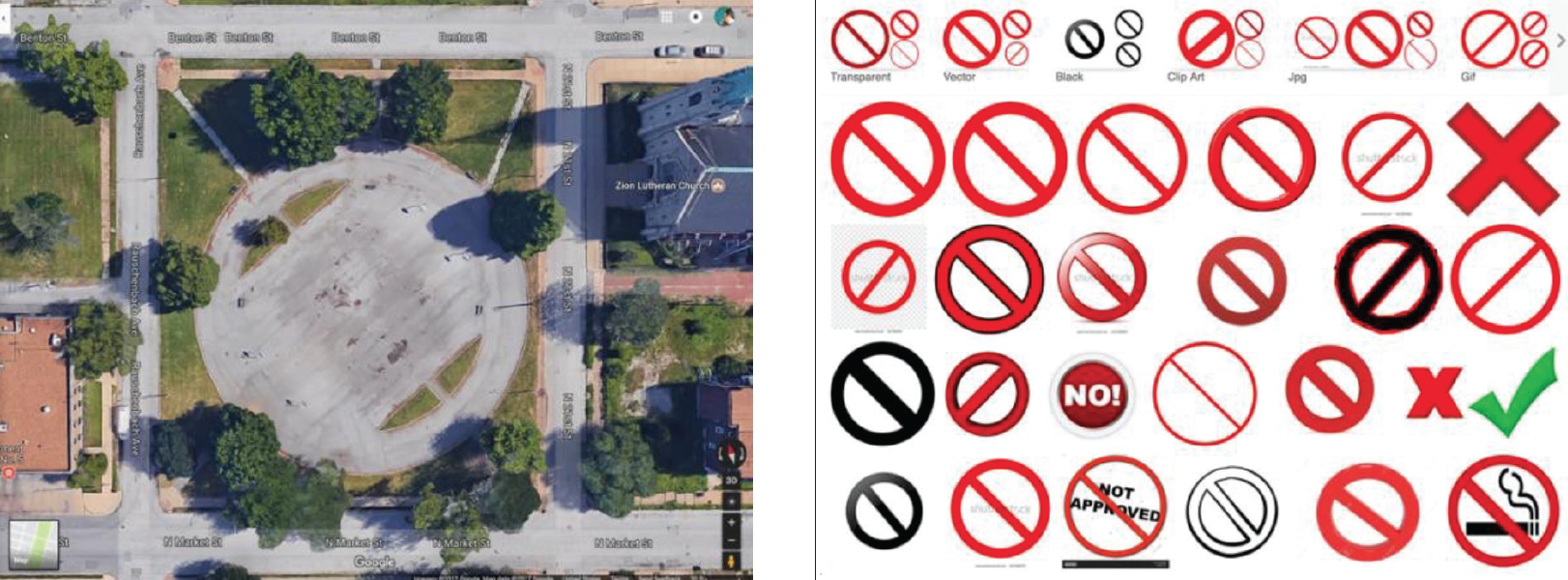
An overhead view of the basketball court at St. Louis Place Park, at left, reveals a shape similar to a “no symbol,” formally known as a prohibition sign. (Map data ©2017 Google. Screenshot by author.) At right, search results for “no symbol” via Google Images. (Retrieved on September 18, 2017. Screenshot by author.)
Race, place, and purity
The history of the United States is fundamentally one of removal and replacement. This dates back to the arrival of European colonists, whose “cultural ideals and moral geographies based on a romance with pure spaces”¹ required the elimination of everything and everyone deemed impure. Though less brutal than the atrocities of extraction suffered by Indigenous Americans, the erasure of African-American communities is in many ways a modern enactment of the same practices. The desire for purity is part of the DNA of our national consciousness. Cleanliness placates our deepest anxieties.
Stepping into an IKEA showroom, Pottery Barn, or Starbucks illustrates the continued cultural pervasiveness of the American preoccupation with the unsullied, the ordered, and the pure. It is no small coincidence that the brick-and-mortar locations of many such retailers exist in places where marginalized communities first had to be removed in order for the stores to be constructed. This occurred in my neighborhood in St. Louis County just over five years ago with the demolition of nineteen acres of Hadley Township. A once close-knit African-American neighborhood now boasts a Menard’s, Treats Unleashed, and European Wax Center.
Destroying the physical fabric of a community smudges out personal histories, shatters social bonds, and tears apart emotional ecosystems.
The purging of perceived defilements shapes the contemporary American landscape in even the most democratic of spaces: the public park. This is exemplified in St. Louis by the “heart and crown jewel” of the city, Forest Park. Spanning 1,300 acres across the city’s central corridor, Forest Park is unsurpassed among the city’s other parks in its immaculate landscaping and cultural prestige. This is due in large part to the private nonprofit conservancy Forest Park Forever. Founded in 1986, they work in partnership with the City of St. Louis to “restore, maintain and sustain Forest Park, as one of America’s great urban public parks.” To this end, Forest Park Forever raised $100 million between 1995 and 2003 to reverse decades of underfunding and deferred maintenance. An additional $139 million in gifts and pledges was fundraised by the end of 2017. The park now draws thirteen million visitors annually and was tabbed among the “Great Places in America” by the American Planning Association. It was also named the best city park in the country by USA Today and the travel website Thrillist.
The most celebrated year in Forest Park’s nearly 150-year history reveals St. Louis’s investment in maintaining a pristine image of the park and the city. In 1904, Forest Park hosted the Louisiana Purchase Exposition. Commonly known as the St. Louis World’s Fair, the seven-month-long event brought nearly twenty million visitors to the park and is widely celebrated as a cultural high point of the city. At the time, St. Louis was the fourth most populous city in the United States and had ambitions of rivaling its northern neighbor, Chicago.
So deep was this desire that St. Louis forced the hand of the International Olympic Committee (IOC) to relocate the 1904 Summer Olympic Games to St. Louis. The Games were originally granted to Chicago. But upon learning that St. Louis was attempting to host the American Athletic Union (AAU) national track and field championships in the summer of that same year—thus drawing some of the top American athletes away from the Olympics—the IOC ultimately decided to move the games to St. Louis.
The 1904 Summer Olympic Games ran concurrently with the World’s Fair and took place immediately west of Forest Park at what is today Francis Olympic Field on the campus of Washington University. These Olympics were the first held outside of Europe, but they were hardly the international event or celebration of global cultures they are today. Only between twelve and fifteen nations participated in the 1904 Games, with U.S. athletes winning 78 of the 96 gold medals and 239 of 280 total medals.
The presence of so many American athletes made possible a series of athletic contests pitting Olympians against the “savages” on display in various international villages at the World’s Fair. Essentially human zoos, these exhibitions included Plains Indian tribesmen as well as indigenous peoples from the Philippines, Central Africa, Mexico, Syria, and Turkey. The two-day athletic event was called “Anthropology Days” (the initial name, “Special Olympics,” did not stick). It was organized by two men: James Sullivan, head of the fair’s department of physical culture, and William McGee, who worked in the fair’s department of anthropology.
The ignominy of Anthropology Days taints the romanticized view of the city’s history as well as the pristine image of a beloved park. Its story is one that St. Louis, collectively, has chosen to leave untold.
The goal of the athletic competition was to demonstrate Anglo-Americans’ physical and racial superiority, a research interest of McGee’s. The first day featured traditional track and field events, many of the rules and conventions of which made no sense to the “primitive” participants. Day two featured “savage-friendly” contests including mud throwing, pole climbing, and “ethnic” dancing. Poorly organized and conceived on the basis of racial pseudoscience, the event was a fiasco and a farce.
As one might imagine, Anthropology Days is rarely spoken of when recounting the glory of 1904 in St. Louis. It does not appear in the extensive store of information posted in the “History of Forest Park” section of the City of St. Louis’s website, nor is it acknowledged in popular tales celebrating the great success of the World’s Fair. The reason for this omission is plain to see: The ignominy of Anthropology Days taints the romanticized view of the city’s history as well as the pristine image of a beloved park. Its story is one that St. Louis, collectively, has chosen to leave untold.
As a fascinating aside, the city needed to resolve a potentially colossal embarrassment before the World’s Fair could even begin. The River des Peres—a section of which flowed through Forest Park—carried odious stench and unsightly waste as a result of being a dumping ground for the sewage of affluent St. Louisans who had moved westward. Without a viable solution before the start of the fair, the city decided to literally cover up the river with a wooden box. This portion of the river is healthier now than it was then, but it remains concealed underneath the park. The symbolism is difficult to ignore.

A former homepage for Forest Park Forever. The wording is noteworthy: ”stewards” suggests caretaking as opposed to designing or engineering, while ”treasure” reinforces the preciousness of the park. (Retrieved January 9, 2018, from https://www.forestparkforever.org/. Screenshot by author.)
Forest Park for whom?
Today, Forest Park would appear to be a far cry from 1904. It boasts an art museum, science center, history museum, zoo, and the United States’ oldest and largest outdoor musical theater, the Muny. Among recent park improvements include a $10.5 million plan to transform its river and lake systems, a $4.5 million seventeen-acre nature playscape, and $3.3 million in renovations to its baseball and softball diamonds. Among the seemingly countless other sports and recreational activities offered by the park are golf, tennis, soccer, cycling, jogging, fishing, handball, ice skating, rollerblading, archery, cricket, rugby, paddle boating, and standup paddleboarding, as well as Irish hurling. A glaring omission, however, is basketball.
Outdoor basketball courts have never existed in Forest Park despite the sport’s rich history in St. Louis. Surprising to many, the city was home to the National Basketball Association (NBA) Champion St. Louis Hawks, who defeated the Boston Celtics for the title in 1958. Three other professional basketball teams have called St. Louis home: the St. Louis Bombers (Basketball Association of America, 1946–49; National Basketball Association, 1949-50); the Spirits of St. Louis (1974–76) of the American Basketball Association (ABA); and the St. Louis Surge, a women’s team that has played in St. Louis since 2011. At the collegiate level, St. Louis has hosted the NCAA Division I Men’s Basketball Final Four on three occasions (1973, 1978, 2005) and the NCAA Division I Women’s Basketball Final Four twice (2001, 2009).
Many believe deeply-rooted racial stereotypes lie at the heart of why Forest Park lacks blacktop courts.
The 1958 Hawks team is notable for being the last NBA Champion to feature a team of all White players. Just two years prior, the Hawks had traded Bill Russell—who they selected with the No. 2 overall pick in the 1956 NBA draft—to Boston in exchange for All-Star Ed Macauley (a St. Louis native) and Cliff Hagan. Russell went on to revolutionize the sport as he led the Celtics to an unprecedented run of 11 NBA titles in 13 seasons. Macauley, Hagan, and Russell are each enshrined in the Basketball Hall of Fame. Macauley and Hagan were White. Russell, an uncompromising activist for racial equality for over sixty years, is Black. By the time the Celtics’ dynasty ended in the late 1960s, the Hawks had relocated to Atlanta. St. Louis has not had a professional men’s basketball team since.
Basketball courts were not included in Forest Park’s 1995 Master Plan nor in any of its subsequent three amendments. Many believe deeply rooted racial stereotypes lie at the heart of why Forest Park lacks black-top courts. Former 21st Ward Alderman Antonio French sought unsuccessfully between 2016 and 2017 to have four lighted outdoor basketball courts placed in Forest Park. “Many people have interpreted the lack of basketball courts as an unwelcome sign,” he lamented, “as a signal that the group that that sport most appeals to is not welcome or encouraged to come to the park.”
Twenty-third Ward Alderman Joseph Vaccaro introduced a similar board bill the following year. Like French’s bill, it made no headway in committee. Said Vaccaro about opposition to his bill, “I’m being told you’re going to stretch police resources. You’re bringing groups into the park that are going to cause problems.” This coded language underscores the assumed association between young Black men, crime, and gangs— “a stereotype,” insisted 18th Ward Alderman Terry Kennedy, “that the city needs to work through.”
Pastor Wendell Sapp of Compton Heights Baptist Church agrees that race plays a significant role in why basketball courts are absent not only in Forest Park, but in parks throughout the city. “I think it probably has to do with the fact that a basketball goal attracts a number of fourteen- to thirty-year-old Black males,” Sapp explained to St. Louis Public Radio in 2017, “and I just don’t think that parks are necessarily looking for some-thing that attracts that particular crowd.” Because of the lack of basketball courts in the city’s public parks, Rev. Sapp has kept a portable hoop in his church’s parking lot since the late 1980s.
Coincidentally, as the respective board bills of French and Vaccaro were having difficulty gaining traction, Tower Grove Park—located several blocks south of Sapp’s church—unveiled a new master plan that includes the reintroduction of basketball courts to its grounds. The second-largest park in the city, Tower Grove Park first installed basketball hoops in 1902 but has been without them since the late 1990s when the court’s asphalt fell into disrepair. “The people have spoken,” states the park’s website, “and they want basketball.”
The Streets vs. The League
The cover art for the video game NBA Live 2018 illustrates how popular culture reinforces the association between Black males, outdoor basketball, and hyper-aggressive masculinity. The artwork portrays two modes of gameplay through the juxtaposition of contrasting portraits of NBA star James Harden.
On the left side of the composition is “The Streets.” Here Harden is turned slightly away from the viewer, with his plain white jersey—evoking the sleeveless shirts known as “wife beaters”—untucked and showing sweat on the chest. The context around “street” Harden includes a chain-link fence, an outdoor basketball hoop, and several park lights in the distance. The color scheme of black, white, and gray emphasizes the brown hues of Harden’s skin. With his head cocked back, eyes clinched, and mouth agape with an angry intensity, “The Streets” is depicted as fierce, unrestrained, and potentially dangerous. Apart from the faintly visible hoop absorbed in the dark night sky, there is no sign of basketball in sight.

An advertisement for the video game “NBA Live 18.” (Retrieved Jan. 13, 2018, from https://news.xbox.com/en-us/2017/08/10/become-the- one-in-nba-live-18/. Screenshot by author.)
In stark contrast, “The League” shows a stable, measured, and non-threatening Harden. His Houston Rockets jersey (officially licensed by the NBA) and the manner in which he wears it (neatly tucked in, per NBA rules for players on the court) feel corporate and orderly. Reinforcing this is Harden’s placement amidst the bright lights and glowing advertisements of a state-of-the-art basketball arena, one that no doubt bears the name of a multi-billion-dollar company. The symmetry of Harden’s pose suggests balance and his cool demeanor conveys confidence. “League” Harden securely holds a basketball with both hands in the vertical center of his body. This is the portrait of an individual who is composed and in control. It also conveys an air of importance. “The Streets” and “The League” are part of the same image, but what and who each represents exist worlds apart. Over a century after Anthropology Days, the dichotomizing of the “savage” and the “civilized” is an impulse that persists.
This visual composition also reinforces a widely accepted hierarchy between two styles of play—institutional basketball and pickup basketball—that date back nearly one hundred years to the Muscular Christianity movement. Viewed as the “right way” to play, institutional basketball is a structured and team-oriented approach to the game that cultivates values of hard work and discipline. It is typically played indoors, under the supervision of a coach, and within the context of a league. Pickup basketball—also known as streetball or playground basketball—is viewed in opposite terms. It is played outdoors and is not subject to the oversight of coaches, referees, or a governing body. Its association with selfish play, lack of discipline, and showboating are viewed as destructive behaviors and values for the team and for oneself.
Recent research refutes these widely held mischaracterizations of streetball and demonstrates that outdoor basketball courts serve as safe havens that strengthen Black community. In Black Gods of the Asphalt: Religion, Hip-Hop, and Street Basketball, author and former college basketball player Onaje X. O. Woodbine argues that pickup basketball cultivates community, offers the opportunity to resist the dehumanization felt in other areas of life, and provides a transcendent, even religious, experience for participants. Sociologist Francisco Vieyra spent a year playing outdoor basketball in New York City as part of his research on the topic. Similar to Woodbine, he found that blacktops are important recreational and leisure spaces where African Americans find refuge, build social networks, and support one another in ways that extend far beyond the blacktop.
For a population never been granted the most basic rights and privileges in the United States, the asphalt court exists as a space of freedom. It is a place where African Americans can congregate, move their bodies without restriction, and feel within themselves a sense of life, belonging, and fulfillment.
Expanded spatial imaginaries
The lack of basketball courts in Forest Park highlights an inability to recognize how different populations conceive of space and how place shapes and reifies collective identity. American studies scholar George Lipsitz identifies two oppositional approaches to space in the United States. The dominant view—termed the “White spatial imaginary”—prioritizes “exchange value” through privileging exclusivity, property value, and capital appreciation. This is the spatial consciousness of those in power and is thus considered normative. Those in the “The League” would be at home here.
Arising in response to this is the “Black spatial imaginary.” Emphasizing “use value,” its hallmarks are sociality, inclusivity, and favoring the public good over private interests. Urban, outdoor basketball courts typify the kind of public space characteristic of the Black spatial imaginary. The courts are important not because of their financial worth on the open market. Their significance is found in being places of recreation and community formation for populations who historically have not had the space or opportunity to congregate, move their bodies freely, and express themselves. Coincidentally, the Greek root of the word asphalt connotes firmness, safety, and security.
By viewing space as a capital asset, practitioners of the White spatial imaginary treat marginalized communities—the land, the buildings, and their residents—as expendable. Marc Lamont Hill details many such African-American communities—those who have been abandoned by the State, left vulnerable, and essentially treated as disposable—in his book, Nobody. St. Louis Place is one such community. The metaphorical equivalent of those whose stories Hill tells is the forlorn blacktop in St. Louis Place Park.
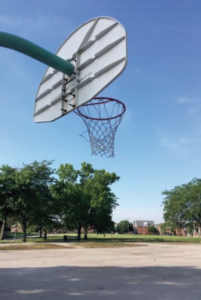
A new net installed on one of the four hoops. (Author photograph)
Despite the basketball court’s apparent desertion, regular visits over the course of several years revealed evidence of perseverance. Previously marred metal garbage cans bore glossy green coats of paint. Fast food bags and cardboard beer cases that were present one month were gone the next. New nylon nets replaced the fraying, torn ones. Where metal fasteners were missing from the rims, zip-ties were installed to secure the nets in place. A tilted light pole that once rested precariously in the branches of a tree once again stood straight and tall.
Whether enacted by civic agencies or private citizens, and whether through compulsion or compassion, the court maintenance is a quiet act of resistance and resilience, of protest and of being. The care-taking of a written-off space is notable in and of itself, but when viewed as gestures that counteract the status quo, these acts of upkeep become symbolic interventions that disrupt our expectations and problematize conventional narratives about the neighborhood and its residents. If we have the eyes to see it, these and other material interventions in the urban landscape can open the imaginative space needed to dismantle calcified assumptions about marginalized communities.
The disequilibration and recalibration offered by these surprise shifts in expectation require a measure of openness and humility. It is a posture toward the world that does not give or impart, but rather that receives with care, attention, and empathy. This is something often discussed with my undergraduate students in art and design each semester. It surprises many of them to learn that drawing well is far less a matter of tool or technique than it is a sensibility of active observation developed over time. Cultivating more humanizing and equitable spatial practices similarly requires paying attention with care and listening in more attentive ways to the stories place tells.
Poetic protest
As a speculative extension of my research for this project, I performed a site-based intervention centered on the small bits of discarded debris scattered across the basketball court at St. Louis Place Park. Among the nearly two dozen objects I gathered were shattered glass, a snipped zip-tie, and a few bottle caps; a QuikTrip cup, some chewed drinking straws, and a Smith & Wesson cartridge case. The material exhaustion of these remnants points beyond their what-ness toward the who that wore, carried, nibbled, touched, twisted, smoked, held, crumpled, bounced, sharpened, shot, threw, smashed, dropped, or drank from them. Trash becomes a trace. What might otherwise be considered as disposable comes to symbolize the individuals who, likewise, have endured neglect and been left behind.
The collected objects were subsequently gilded with 24-karat gold. Applied as a covering that adorns, gold leaf is also a material that can reveal. Traditionally, surfaces are treated prior to gilding to ensure a smooth and uniform application of the leaf. These objects were gilded without any such preparation so that the gold leaf’s luster and thinness would highlight every mark, blemish, scratch, and trace of wear. Not only does the gold leaf itself suggest a reversal of value for these castaway objects, but the manner in which they were photographed elevates them as well. Referencing museum documentation of gilded artifacts and other objects made of gold, the decontextualized blue-green backdrop presents the gilt remnants as objets d’art.
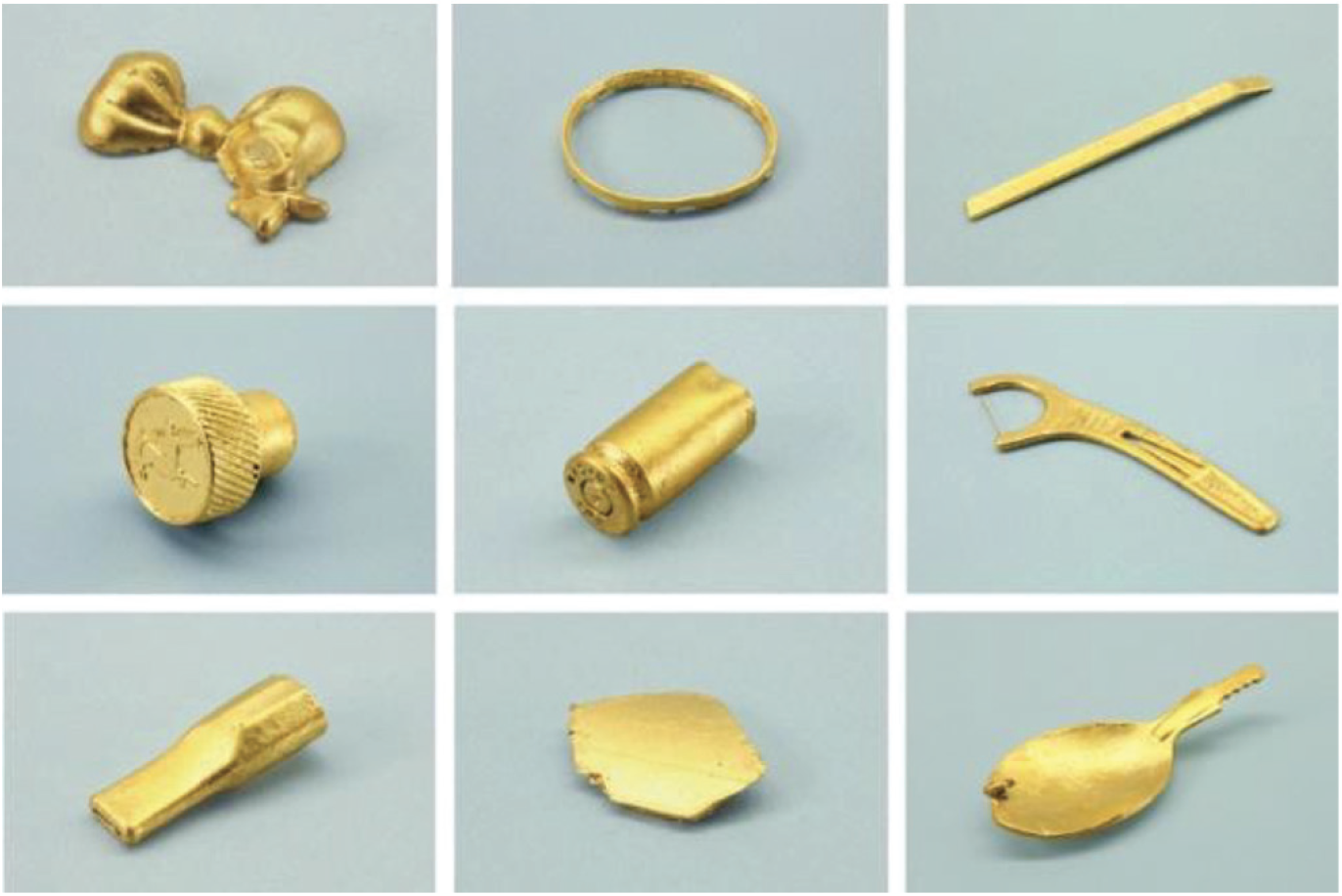
Nine of the objects gathered from the basketball court after gilding. (Author photograph)
The final stage of the intervention involved throwing the gilded objects over the construction fence at the National Geospatial-Intelligence Agency site. Embedding objects from a place where African-American community is formed into a place where African-American community has been erased defiantly claims presence in the face of removal. While it is possible that these golden remnants could be unearthed decades from now when the NGA headquarters is no longer state of the art and the soil underneath is once again broken apart, their mere existence testifies of those in St. Louis Place who have been overlooked, forgotten, and not treated with human dignity. Reintroducing these objects into the urban landscape interrupts the flow of history and acts as a refusal to accept that the way things are, in fact, is the way things should be.
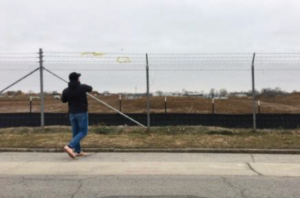
Throwing a gilded object over the fence of the NGA site. (Photograph by Alexander Early)
Prior to remediation and demolition of the NGA site, federally mandated archaeological research took place throughout the blighted ninety-nine acres of St. Louis Place in the summer of 2016. Informational flyers announcing the dig to area residents displayed the motto “understanding our past to improve our future.” For St. Louis to become a more just, equitable, and whole city, perhaps what is needed as much as looking back is to acknowledge with greater openness and understanding how aggrieved urban communities are being treated in the present. Being increasingly attentive and responsive to the ways in which place, in many ways, speaks for itself might begin to help us do just that.
